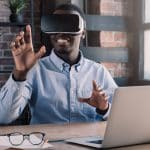From the early days of flimsy 3D glasses to the sophisticated headsets of today, the evolution of virtual reality (VR) has been nothing short of phenomenal. The digital revolution is propelling the world into a future where the lines between the physical and virtual worlds are getting more and more blurred. Nowhere is this more evident than in the realm of entertainment.
Multi-sensory VR is the latest chapter in this ongoing evolution, promising to deliver even more immersive experiences by engaging not just sight and sound, but also touch, smell and taste. As a result, the UK entertainment sector, which has always been at the forefront of technological innovation, is set to undergo a seismic shift.
Cela peut vous intéresser : How Are Exoskeletons Being Used to Support UK Workers in Heavy Industry?
The Rise of Multi-Sensory VR Experiences
The emergence of multi-sensory VR is a game-changer. Standard VR offers visually immersive experiences, but multi-sensory VR goes a step further. It introduces physical stimuli, such as temperature variations, olfactory cues and tactile feedback, into the virtual environment.
Imagine experiencing the chill of an arctic wilderness, the scent of a forest after rain, or the sensation of raindrops on your skin, all while sitting comfortably in your living room. This is the sort of realism that multi-sensory VR can achieve.
Cela peut vous intéresser : Are Programmable Materials the Future of Self-Healing Structures?
Google, a major player in the VR space, has already made strides in this direction with projects like Google Cardboard and Daydream. The company is investing heavily in the development of multi-sensory VR technologies.
Teaching and Learning in an Immersive Digital World
The implications of multi-sensory VR are not limited to entertainment. It also has the potential to revolutionise the way we learn. The use of VR in education, or VR learning, has been gaining traction worldwide, with the UK leading the charge.
VR learning is a form of experiential learning, where students don’t just read or hear about things; they experience them. For instance, a history lesson about the Roman Empire could involve a virtual tour of ancient Rome, or a geography lesson about the Amazon Rainforest could involve a virtual expedition.
When you add multi-sensory elements to this equation, the learning experience becomes even more engaging. Feeling the heat of a virtual sun or smelling the virtual flowers could enhance recall and deepen understanding. It’s a far cry from the traditional classroom setting, and it’s a trend that’s set to reshape the entire education sector.
Redefining Entertainment with Multi-Sensory VR
In the realm of entertainment, VR has already made a significant impact. From VR gaming to virtual concerts and theatre performances, VR has transformed the way we consume content.
Now, with the advent of multi-sensory VR, the entertainment industry is set to undergo another transformation. The ability to engage multiple senses will make VR experiences even more immersive and realistic.
Imagine watching a cooking show and being able to smell the food, or playing a video game and feeling the impact of virtual objects. These are the sorts of experiences that multi-sensory VR can deliver.
The UK entertainment sector, which has always been a hotbed of innovation, is ideally placed to capitalise on this trend. Companies like Crossref are at the forefront of these developments, working on cutting-edge projects that push the boundaries of what’s possible with VR.
The Challenges and Opportunities Ahead
Despite the tremendous potential of multi-sensory VR, there are still significant challenges that need to be overcome. For starters, creating multi-sensory content is a complex and time-consuming process. It involves not just creating visual and audio content, but also simulating physical stimuli.
Also, while the technology for delivering sight and sound in VR is fairly mature, the technologies for delivering touch, smell and taste are still in their infancy. There’s a lot of research and development that needs to be done in these areas.
On the positive side, the challenges also present opportunities. Companies that can overcome these hurdles and deliver compelling multi-sensory VR experiences stand to reap significant rewards. The market potential is enormous, not just in entertainment, but also in fields like education, training, tourism, and healthcare.
Social and Ethical Considerations
As we look ahead to the future of multi-sensory VR, it’s also important to consider the social and ethical implications. For instance, there are questions about how immersive VR experiences might impact our mental and physical health. There are also concerns about privacy, as VR technologies are capable of collecting a vast amount of personal data.
This calls for a careful and considered approach to the development and deployment of multi-sensory VR technologies. Companies need to work with regulators, scholars, and the public to ensure that these technologies are used in a way that respects our fundamental rights and values.
In conclusion, multi-sensory VR holds incredible promise for the future of entertainment in the UK. The journey may be fraught with challenges, but with a thoughtful and responsible approach, we can navigate these hurdles and usher in a new era of immersive digital experiences.
Driving Innovation with Cutting-Edge VR Technologies
Innovation is the lifeblood of the creative industries. As augmented reality and virtual reality technologies become more sophisticated, companies that can harness these technologies will have a significant competitive advantage.
Google Scholar is a valuable resource for researchers, developers, and companies looking to stay at the forefront of VR technology. It provides access to scholarly articles, patents, and theses, enabling them to keep up-to-date with the latest developments.
One of the key challenges for VR developers is creating realistic multi-sensory stimuli. While sight and sound stimuli are relatively straightforward to create, more complex stimuli, like olfactory stimuli, are more difficult. Nevertheless, companies around the world are working tirelessly to overcome these hurdles.
Take, for instance, the work being done by Digital Catapult, a leading UK technology company. They have been developing cutting-edge immersive technologies that can simulate a wide range of sensory stimuli. Their work is helping to drive the VR revolution and pave the way for more immersive virtual environments.
Similarly, Group Participants, a collective of VR developers, have been experimenting with creating more immersive experiences by engaging multiple senses in real time. For example, they have developed location-based VR experiences that can be tailored to the specific needs of the audience.
The UK’s industrial strategy is also playing a critical role in fostering the growth of innovative VR companies. The government has been investing heavily in VR research and development, aiming to make the UK a global leader in this field.
The Future of Multi-Sensory VR: A New Era of Immersive Experiences
Looking ahead, the possibilities for multi-sensory VR are virtually limitless. The convergence of VR and multi-sensory technology could usher in a new era of ultra-realistic, immersive experiences that blur the lines between the virtual and the real world.
Imagine watching a football game and not only seeing and hearing the action but also feeling the vibrations of the crowd and smelling the grass on the pitch. Or imagine playing a video game and feeling the heat from virtual explosions or the chill from a virtual snowstorm. These are the sorts of experiences that multi-sensory VR could make possible.
Location-based VR experiences, which use physical space to enhance the virtual experience, could also become more common. For example, VR theme parks could offer physically immersive rides that combine virtual environments with real-world sensations.
As the technology matures, we can also expect to see more applications of multi-sensory VR in fields beyond entertainment. For instance, in healthcare, multi-sensory VR could be used for pain management or rehabilitation. In education, it could provide more immersive and engaging learning experiences.
Ultimately, the future of multi-sensory VR will be shaped by the creativity, ingenuity, and vision of the companies and developers working in this field. With the right mix of technology, creativity, and a deep understanding of human senses, they have the potential to create truly amazing and immersive virtual experiences.
In conclusion, the future of multi-sensory VR in the UK entertainment sector looks incredibly promising. While there are still challenges to overcome, the progress that has been made so far is truly exciting. As we move forward, we can look forward to a new era of immersive experiences that engage all our senses. With bold vision and technological innovation, the possibilities are virtually limitless.











